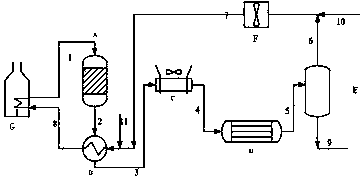Method for preparing xylene by shape-selective disproportionation of toluene
A technology of p-xylene and toluene, which is applied in the field of toluene shape-selective disproportionation to p-xylene, can solve the problem of replenishing hydrogen consumption and achieve the effect of reducing consumption
- Summary
- Abstract
- Description
- Claims
- Application Information
AI Technical Summary
Problems solved by technology
Method used
Image
Examples
Embodiment 1
[0026] In this process embodiment, it is assumed that the conversion rate of toluene is 30%, and the supplementary hydrogen contains 92% hydrogen. The following embodiments are the same.
[0027] The reaction aromatics feed containing 99% toluene and the circulating hydrogen containing 90.5% are exchanged through the inlet and outlet materials, and then fed through the heating furnace. The materials enter the reactor containing ZSM-5 molecular sieve catalysts. Then after air cooling, the material is water cooled and the temperature is 25°C, and it enters the gas-liquid separator for separation. The circulating gas phase contains 89% hydrogen, and the circulating hydrogen is not exhausted. The compression cycle is returned to the reaction system, and the liquid phase enters the subsequent liquid phase separation system.
[0028]
Embodiment 2
[0030] The reaction aromatics feed containing 80% toluene and the circulating hydrogen containing 86.0% are exchanged through the inlet and outlet materials, and then fed through the heating furnace. The materials enter the reactor containing the ZSM-11 molecular sieve catalyst. Then the material is air-cooled and then water-cooled at a temperature of 50°C. It enters the gas-liquid separator for separation. The circulating gas phase contains 81.0% hydrogen, and the circulating hydrogen is not exhausted. The compression cycle is returned to the reaction system, and the liquid phase enters the subsequent liquid phase separation system.
[0031]
Embodiment 3
[0033] The reaction aromatics feed containing 70% toluene and the circulating hydrogen containing 88.0% are exchanged through the inlet and outlet materials and then fed into the heating furnace. The materials enter the reactor containing ZSM-5 molecular sieve catalysts. Then after air cooling, the material is water cooled and the temperature is 10°C, and it enters the gas-liquid separator for separation. The circulating gas phase contains 86.0% hydrogen, and the circulating hydrogen is not exhausted. The compression cycle is returned to the reaction system, and the liquid phase enters the subsequent liquid phase separation system.
[0034]
PUM
 Login to View More
Login to View More Abstract
Description
Claims
Application Information
 Login to View More
Login to View More - R&D
- Intellectual Property
- Life Sciences
- Materials
- Tech Scout
- Unparalleled Data Quality
- Higher Quality Content
- 60% Fewer Hallucinations
Browse by: Latest US Patents, China's latest patents, Technical Efficacy Thesaurus, Application Domain, Technology Topic, Popular Technical Reports.
© 2025 PatSnap. All rights reserved.Legal|Privacy policy|Modern Slavery Act Transparency Statement|Sitemap|About US| Contact US: help@patsnap.com

